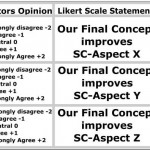Week.8 Likert Scale Methodology
Likert Scale Methodology / Theory Main Line
A likert Scale is a psychometric scale commonly used in questionaires, and is the most widely used scale in survey research, such that the term is often used intercangeably with rating scale even though the two are not synonymous. When responding to a Likert questionaire item, respondents specify their level of agreement to a statement. The scale is named after its inventor, psychologist
Rensis Likert. An important distinction must be made between a Likert Scale and a Likert Item. The Likert scale is the sum of responses on several Likert items. Because Likert items are often accompanied by a visual analog scale, the items are called sometimes scales themselves. A Likert item is simply a statement which the respondent is asked to evaluate according to any kind of subjective criteria; generally the level of agreement or disagreement is measured. Often five ordered response levels are used, although many psychometricians advocate using seven or nine levels; The format of typical five-level Likert item is:
1. Strongly disagree
2. Disagree
3. Neither agree nor disagree
4. Agree
5. Strongly agree
After the questionnaire is completed, each item can be analyzed separately or in some cases item responses yam be summed to create a score for a group of items. Hence, Likert scales are often called assumptive scales.

References
Wuensch, Karl L. , 2005. “What is a Likert Scale? and How Do You Pronounce ‘Likert?'”. East Carolina University.
Likert, Rensis ,1932, “A Technique for the Measurement of Attitudes”. Archives of Psychology 140: 1–55.
Mogey, Nora ,1999, “So You Want to Use a Likert Scale?”. Learning Technology Dissemination Initiative. Heriot-Watt University.
Babbie, Earl R. ,2005, The Basics of Social Research. Belmont, CA: Thomson Wadsworth. p. 174. ISBN 0534630367.
Trochim, William M. ,2006. “Likert Scaling”. Research Methods Knowledge Base, 2nd Edition..
Meyers, Lawrence S.; Anthony Guarino, Glenn Gamst ,2005. Applied Multivariate Research: Design and Interpretation. Sage Publications. p. 20. ISBN 1412904129.



